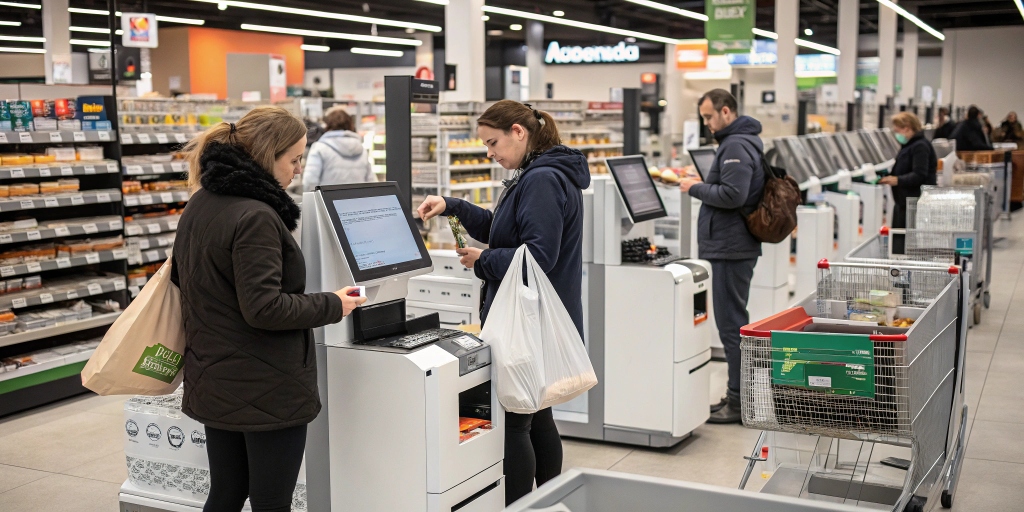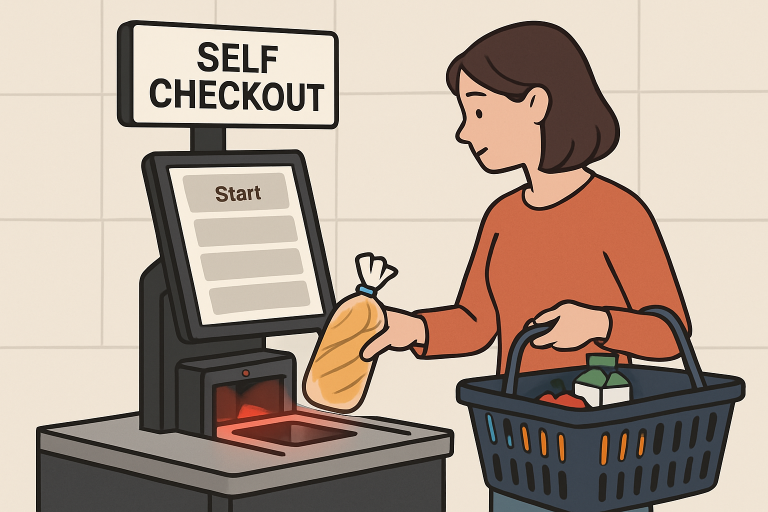
Self-Checkout Systems in Modern Retail: Balancing Convenience and Challenges
Key Takeaways:
- Self-checkout systems offer speed and convenience, but they also come with challenges, such as increased theft and customer dissatisfaction.
- Retailers are re-evaluating self-checkout strategies, with some limiting or removing these systems.
- Innovations such as AI and RFID technology are being explored to enhance the efficiency and security of self-checkout.
Introduction
Modern retail environments are rapidly evolving, and one of the most notable transformations is the proliferation of self-checkout technologies. These systems enable shoppers to scan, bag, and pay for items with minimal employee interaction, which can be found in supermarkets, big box stores, and convenience outlets across the country. Solutions like kiosk self-checkout terminals have become commonplace, offering a blend of speed, independence, and operational savings for retailers eager to meet customer expectations and streamline in-store experiences.
Despite the broad adoption and many benefits, the rush towards automation has introduced a new layer of complexity. Shrinkage, shopper confusion, and questions about customer service have prompted retailers and industry experts to reassess their approach to self-service technology. The evolving retail landscape now requires a careful balance between efficiency gains and the potential pitfalls that come with less human oversight at checkout.
As retailers debate how much automation is too much, shoppers themselves have mixed feelings: some love the newfound control and quicker checkouts, while others struggle with glitches, technical issues, or miss the personal interaction a cashier can offer. This dynamic technology is not just a tool for faster shopping but represents a shift in how businesses and consumers interact at a fundamental level.
With innovation on the rise and significant investment in self-checkout infrastructure, questions about the optimal mix of automation and customer service—and the best approach to addressing mounting concerns about theft and usability—loom large over the retail sector. The following exploration delves into the factors that shape the rise, controversy, and future of self-checkout systems.
The Rise of Self-Checkout Systems
Self-checkout solutions first appeared in North American grocery outlets in the late 1980s. As technology advanced, retailers seized the opportunity to reduce wait times and cut staffing costs, leveraging these systems to offer customers a faster, more flexible way to pay. By 2023, the United States is expected to lead the way as the largest self-checkout market worldwide, with usage driven by grocery chains, mass merchandisers, and the convenience retail sector. Global self-checkout terminal shipments reached a milestone of over 217,000 units in 2023, marking a 12% increase from the previous year, reflecting consistent demand from retailers and growing consumer familiarity.
Retailers often cite the promise of cost savings through reduced labor requirements as a key driver of adoption. Meanwhile, studies show that many customers appreciate having options—especially during high-traffic times when lines for traditional cashier lanes can grow long. As a result, self-checkout has come to symbolize innovation and progress in customer service within the retail ecosystem.

Challenges and Controversies
The benefits of faster and more convenient shopping have not come without new hurdles. Notably, theft, both accidental and deliberate, has taken center stage in recent conversations about self-checkout. According to an industry survey, 15% of shoppers admitted to purposefully stealing at self-checkout. Accidental theft is also prevalent; 21% of customers surveyed reported inadvertently leaving with unpaid items, and a staggering 61% decided to keep those items instead of returning them.
Beyond concerns about shrinkage, many users have highlighted frustrations, including confusing touchscreens, barcode scanning issues, and unclear bagging instructions. While these pains may seem minor, they can add up, leading to negative experiences for both infrequent and loyal customers.
Retailers Rethinking Self-Checkout
Given the rising costs associated with shrinkage and the potential for customer dissatisfaction, retailers are reconsidering how and when to deploy self-checkout systems. Notably, Target made headlines in March 2024 by restricting self-checkout lanes to customers with 10 items or fewer. This move was designed to alleviate long wait times, prevent potential theft, and create a smoother experience for both shoppers and employees. Other major brands, including Walmart and Dollar General, are also experimenting with limiting self-checkout hours or types of transactions as they seek the right balance between automation and oversight.
These steps represent a new phase in the roll-out of self-checkout technology, as retailers try to maximize convenience while minimizing risks and negative perceptions.
Technological Innovations
To resolve key pain points, the next generation of self-checkout systems incorporates cutting-edge advances. Leading companies are integrating artificial intelligence (AI) and computer vision to enhance checkout accuracy, instantly recognizing and weighing produce or alerting staff to suspicious transactions. Some stores are piloting RFID (radio-frequency identification) tags, which enable the simultaneous scanning of groups of products, dramatically speeding up the process.
AI and Security Enhancements
AI-driven fraud detection models can proactively flag unusual purchasing patterns, helping retailers preempt theft without the need for constant human monitoring. Real-time video analytics, machine learning algorithms, and even biometric validation are all being explored as ways to secure and streamline self-checkout for both retailers and shoppers.
Consumer Perspectives
Surveys suggest a divided customer base. Approximately 62% of self-checkout users are drawn to the lanes due to their efficiency, with 44% citing the avoidance of long queues as a major benefit. However, technical hiccups and the lack of personal assistance frustrate some; 19% of surveyed shoppers say social anxiety or a privacy preference motivates them to choose self-service, while others feel alienated by the lack of human interaction. As expectations and comfort with digital experiences grow, shoppers are prioritizing both ease of use and assurance that their payment and product selection process will be smooth and reliable.
Future Outlook
The trajectory of self-checkout technology points toward a hybrid future—where automated solutions coexist with traditional lanes, and digital security plays as significant a role as customer convenience. Retailers will need to continually evaluate which solutions best align with their customer base and operational needs. New innovations, such as advanced AI, facial recognition, and integrated payment options, will help address pain points and potentially pave the way for cashierless stores that truly deliver on the promise of seamless, secure, and satisfying in-store experiences.
Conclusion
Self-checkout systems have fundamentally reshaped retail by offering a blend of automation, efficiency, and new challenges. As the sector faces ongoing shifts in technology, consumer preferences, and operational pressures, the retailers that thrive will be those that embrace not only the latest tools but also a holistic approach to customer experience, security, and adaptability.



Average Rating